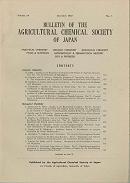Volume 22, Issue 2
Displaying 1-14 of 14 articles from this issue
- |<
- <
- 1
- >
- >|
-
1958Volume 22Issue 2 Pages 10
Published: 1958
Released on J-STAGE: November 27, 2008
Download PDF (10K) -
1958Volume 22Issue 2 Pages 63-68
Published: 1958
Released on J-STAGE: November 27, 2008
Download PDF (402K) -
1958Volume 22Issue 2 Pages 68-77
Published: 1958
Released on J-STAGE: November 27, 2008
Download PDF (551K) -
1958Volume 22Issue 2 Pages 78-84
Published: 1958
Released on J-STAGE: November 27, 2008
Download PDF (433K) -
1958Volume 22Issue 2 Pages 85-91
Published: 1958
Released on J-STAGE: November 27, 2008
Download PDF (431K) -
1958Volume 22Issue 2 Pages 91-97
Published: 1958
Released on J-STAGE: November 27, 2008
Download PDF (1162K) -
1958Volume 22Issue 2 Pages 98-103
Published: 1958
Released on J-STAGE: November 27, 2008
Download PDF (991K) -
1958Volume 22Issue 2 Pages 103-108
Published: 1958
Released on J-STAGE: November 27, 2008
Download PDF (397K) -
1958Volume 22Issue 2 Pages 108-116
Published: 1958
Released on J-STAGE: November 27, 2008
Download PDF (692K) -
1958Volume 22Issue 2 Pages 117-122
Published: 1958
Released on J-STAGE: November 27, 2008
Download PDF (306K) -
1958Volume 22Issue 2 Pages 123-124
Published: 1958
Released on J-STAGE: November 27, 2008
Download PDF (101K) -
1958Volume 22Issue 2 Pages 125-126
Published: 1958
Released on J-STAGE: November 27, 2008
Download PDF (649K) -
1958Volume 22Issue 2 Pages 127
Published: 1958
Released on J-STAGE: November 27, 2008
Download PDF (1712K) -
1958Volume 22Issue 2 Pages 128-130
Published: 1958
Released on J-STAGE: November 27, 2008
Download PDF (175K)
- |<
- <
- 1
- >
- >|
